Design and Evaluation of a Crowdsourcing Precision Agriculture Mobile Application for Lambsquarters, Mission LQ
Abstract
:1. Introduction
2. Background
2.1. Precision Agriculture
- Data Collection: spectrometer data is taken of Fuji apple tree leaves.
- Data Analysis: spectra analyzed for wavelengths that indicate the presence of Marssonina blotch disease.
- Prescription: analysis used to create a prescription map in ArcGIS.
- Application: prescription map used for the application of pesticide in the apple orchard.
2.2. Crowdsourcing Initiatives in Agriculture
2.3. Human-Centered Design
2.4. Lambsquarters
3. Materials and Methods
3.1. Research Questions and Hypotheses
- R: To what degree can the barriers faced by individuals be alleviated by the prototype?
- R: To what extent will the prototype developed be considered “satisfactorily” usable?
- R: To what extent will the prototype be able to achieve the learning objective of classifying agricultural features?
- H: Users will find the prototype does not address the barriers in participating in agricultural crowdsourcing initiatives.
- H: Users will find the prototype does address the barriers in participating in agricultural crowdsourcing initiatives.
- H: Users will find the prototype developed to be less than “satisfactorily” usable.
- H: Users will find the prototype developed to be at least “satisfactorily” usable.
- H: Users will not be able to classify agriculture features as accurately as an expert.
- H: Users will be able to classify agriculture features at least as accurately or more accurately than an expert.
3.2. Human-Centered Design Protocol
3.2.1. Identifying the Need for Human-Centered Design
3.2.2. Understanding and Specifying the Context of Use
3.2.3. Specifying the User and Organizational Requirements
3.2.4. Producing Design Solutions
3.2.5. Evaluating the Design against the Requirements
3.2.6. The System Satisfies the Specified User and Organizational Requirements
3.3. Smartphone Design
3.4. Desktop Design
3.5. Recruitment
3.5.1. Recruitment: Design Iteration 1
3.5.2. Recruitment: Design Iteration 2
3.6. User Study
3.6.1. User Study: Design Iteration 1
3.6.2. User Study: Design Iteration 2
3.7. Evaluation
4. Results
4.1. Demographic Results
4.1.1. Demographic Results: Design Iteration 1
4.1.2. Demographic Results: Design Iteration 2
4.2. Usability Evaluation Results
4.2.1. System Usability Scale Results: Design Iteration 1
4.2.2. Qualitative Results: Design Iteration 1
4.2.3. System Usability Scale Results: Design Iteration 2
4.2.4. Qualitative Results: Design Iteration 2
4.3. Lambsquarters Results
4.3.1. Classification Rates
4.3.2. Vegetation Map
5. Discussion
5.1. Research Question 1
5.2. Research Question 2
5.3. Research Question 3
6. Conclusions
Author Contributions
Funding
Institutional Review Board Statement
Informed Consent Statement
Data Availability Statement
Acknowledgments
Conflicts of Interest
Abbreviations
| CAUSES | College of Agriculture, Sustainability and Environmental Sciences |
| D.C. | District of Columbia |
| DMV | D.C., Maryland, and Virginia |
| DSS | decision support systems |
| GPS | global positioning system |
| ITIS | Integrated Taxonomic Information System |
| MBaaS | mobile back end as service |
| PA | precision agriculture |
| SPSS | Statistical Package for the Social Sciences |
| SUS | System Usability Scale |
| USDA | United States Department of Agriculture |
| USGS | United States Geological Survey |
References
- Food and Agriculture Organization of the United Nations The State of Food and Agriculture 2014 IN BRIEF. Available online: http://www.fao.org/3/a-i4036e.pdf (accessed on 20 May 2019).
- Riquelme, J.A.L.; Soto, F.; Suardiaz, J.; Sanchez, P.; Iborra, A.; Vera, J.A. Wireless Sensor Networks for precision horticulture in Southern Spain. Comput. Electron. Agric. 2009, 68, 25–35. [Google Scholar] [CrossRef]
- Santos, I.M.; da Costa, F.G.; Cugnasca, C.E.; Ueyama, J. Computational simulation of wireless sensor networks for pesticide drift control. Precis. Agric. 2014, 15, 290–303. [Google Scholar] [CrossRef]
- Thompson, N.M.; Bir, C.; Widmar, D.A.; Mintert, J.R. Farmer Perceptions of Precision Agriculture Technology Benefits. J. Agric. Appl. Econ. 2019, 51, 142–163. [Google Scholar] [CrossRef] [Green Version]
- Wolfert, S.; Ge, L.; Verdouw, C.; Bogaardt, M.J. Big data in smart farming—A review. Agric. Syst. 2017, 153, 69–80. [Google Scholar] [CrossRef]
- Sykuta, M.E. Big Data in Agriculture: Property Rights, Privacy and Competition in Ag Data Services. Int. Food Agribus. Manag. Rev. 2016, 19, 57–74. [Google Scholar]
- Schuster, J. Big Data Ethics and the Digital Age of Agriculture. Resour. Mag. 2017, 24, 20–21. [Google Scholar]
- Shipman, M. Interpreting the Growing Field of On-Farm Data. 2019. Available online: https://news.ncsu.edu/2019/10/on-farm-data/ (accessed on 15 February 2020).
- Bendre, M.R.; Thool, V.R. Analytics, challenges and applications in big data environment: A survey. J. Manag. Anal. 2016, 3, 206–239. [Google Scholar] [CrossRef]
- Physical Oceanography Distributed Active Archive Center (PO.DAAC). 2015. Available online: https://podaac.jpl.nasa.gov/ (accessed on 11 January 2018).
- Kamilaris, A.; Kartakoullis, A.; Prenafeta-Boldú, F.X. A review on the practice of big data analysis in agriculture. Comput. Electron. Agric. 2017, 143, 23–37. [Google Scholar] [CrossRef]
- Minet, J.; Curnel, Y.; Gobin, A.; Goffart, J.P.; Mélard, F.; Tychon, B.; Wellens, J.; Defourny, P. Crowdsourcing for agricultural applications: A review of uses and opportunities for a farmsourcing approach. Comput. Electron. Agric. 2017, 142, 126–138. [Google Scholar] [CrossRef] [Green Version]
- Lowenberg-DeBoer, J.; Erickson, B. Setting the record straight on precision agriculture adoption. Agron. J. 2019, 111, 1552–1569. [Google Scholar] [CrossRef] [Green Version]
- Schimmelpfennig, D.; Ebel, R. Sequential adoption and cost savings from precision agriculture. J. Agric. Resour. Econ. 2016, 41, 97–115. [Google Scholar]
- Schimmelpfennig, D. Farm Profits and Adoption of Precision Agriculture; Economic Research Service. ERR-217; U.S. Department of Agriculture: Honolulu, HI, USA, 2016.
- Schimmelpfennig, D. Cost Savings From Precision Agriculture Technologies on US Corn Farms. Amber Waves 2016. Available online: https://www.ers.usda.gov/amber-waves/2016/may/cost-savings-from-precision-agriculture-technologies-on-us-corn-farms (accessed on 20 June 2021).
- Bora, G.C.; Nowatzki, J.F.; Roberts, D.C. Energy savings by adopting precision agriculture in rural USA. Energy Sustain. Soc. 2012, 2, 22. [Google Scholar] [CrossRef] [Green Version]
- Deere, J.; Ess, D.; Morgan, M. The Precision Farming Guide for Agriculturists; Cengage Learning: Boston, MA, USA, 2003. [Google Scholar]
- Chaterji, S.; DeLay, N.; Evans, J.; Mosier, N.; Engel, B.; Buckmaster, D.; Chandra, R. Artificial Intelligence for Digital Agriculture at Scale: Techniques, Policies, and Challenges. arXiv 2020, arXiv:2001.09786. [Google Scholar]
- Dickinson, J.L.; Shirk, J.; Bonter, D.; Bonney, R.; Crain, R.L.; Martin, J.; Phillips, T.; Purcell, K. The current state of citizen science as a tool for ecological research and public engagement. Front. Ecol. Environ. 2012, 10, 291–297. [Google Scholar] [CrossRef] [Green Version]
- Steinke, J. New Opportunities for Agricultural Extension Services: Mainstreaming Large-Scale Farmer Participation through Modern ICT. Ph.D. Thesis, Humboldt-Universitat zu Berlin, Berlin, Germany, 2019. [Google Scholar]
- Lokers, R.; Knapen, R.; Janssen, S.; van Randen, Y.; Jansen, J. Analysis of Big Data technologies for use in agro-environmental science. Environ. Model. Softw. 2016, 84, 494–504. [Google Scholar] [CrossRef] [Green Version]
- Matheson, C.A. iNaturalist. Ref. Rev. 2014, 28, 36–38. [Google Scholar]
- Ochieng, H.O.; Ojiem, J.; Otieno, J. Farmer Versus Researcher Data Collection Methodologies: Understanding Variations and Associated Trade-Offs; AfricArxiv ncw8a; Center for Open Science: Charlottesville, VA, USA, 2019. [Google Scholar]
- Marshall, M.; Crommelinck, S.; Kohli, D.; Perger, C.; Yang, M.Y.; Ghosh, A.; Fritz, S.; de Bie, K.; Nelson, A. Crowd-Driven and Automated Mapping of Field Boundaries in Highly Fragmented Agricultural Landscapes of Ethiopia with Very High Spatial Resolution Imagery. Remote Sens. 2019, 11, 2082. [Google Scholar] [CrossRef] [Green Version]
- Koskinen, J.; Leinonen, U.; Vollrath, A.; Ortmann, A.; Lindquist, E.; d’Annunzio, R.; Pekkarinen, A.; Kayhko, N. Participatory mapping of forest plantations with Open Foris and Google Earth Engine. Isprs J. Photogramm. Remote Sens. 2019, 148, 63–74. [Google Scholar] [CrossRef]
- Posadas, B.B. A Survey of Low-Cost Precision Agricultural Technologies; 2017; Unpublished Manuscript. [Google Scholar]
- Ferrandez-Pastor, F.J.; Garcia-Chamizo, J.M.; Nieto-Hidalgo, M.; Mora-Martinez, J. Precision Agriculture Design Method Using a Distributed Computing Architecture on Internet of Things Context. Sensors 2018, 18, 1731. [Google Scholar] [CrossRef] [Green Version]
- Lindblom, J.; Lundstrom, C.; Ljung, M.; Jonsson, A. Promoting sustainable intensification in precision agriculture: Review of decision support systems development and strategies. Precis. Agric. 2017, 18, 309–331. [Google Scholar] [CrossRef] [Green Version]
- Zaks, D.P.M.; Kucharik, C.J. Data and monitoring needs for a more ecological agriculture. Environ. Res. Lett. 2011, 6, 014017. [Google Scholar] [CrossRef]
- Mirshekari, B. Marigold (Calendula officinalis) yield as affected by lamb’s-quarters (Chenopodium album) competition. Int. J. Plant Prod. 2013, 7, 659–664. [Google Scholar]
- Weaver, S. Impact of lamb’s-quarters, common ragweed and green foxtail on yield of corn and soybean in Ontario. Can. J. Plant Sci. 2001, 81, 821–828. [Google Scholar] [CrossRef]
- Medve, R.J.; Medve, M.L. Edible Wild Plants of Pennsylvania and Neighboring States; Penn State Press: University Park, PA, USA, 2010. [Google Scholar]
- Benoliel, D. Northwest Foraging: The Classic Guide to Edible Plants of the Pacific Northwest; Skipstone: Griffin, CA, USA, 2011. [Google Scholar]
- Elias, T.S.; Dykeman, P.A. Edible Wild Plants: A North American Field Guide to Over 200 Natural Foods; Sterling Publishing Company, Inc.: New York, NY, USA, 2009. [Google Scholar]
- Of Agriculture Natural Resources Conservation Service, U.S.D. Chenopodium album L. lambsquarters. Available online: https://plants.usda.gov/core/profile?symbol=chal7 (accessed on 22 January 2020).
- On-Line Database, I.T.I.S. Chenopodium album var. album L. Available online: https://www.itis.gov/servlet/SingleRpt/SingleRpt?search_topic=TSN&search_value=531163#null (accessed on 22 January 2020).
- Šerá, B.; Šerý, M.; Štrañák, V.; Špatenka, P. Does cold plasma affect breaking dormancy and seed germination? A study on seeds of Lamb’s Quarters (Chenopodium album agg.). Plasma Sci. Technol. 2009, 11, 750. [Google Scholar] [CrossRef]
- Šerá, B.; Novák, F. The effect of humic substances on germination and early growth of Lamb’s Quarters (Chenopodium album agg.). Biologia 2011, 66, 470. [Google Scholar] [CrossRef]
- Ullah, M.; Khan, M.U.; Mahmood, A.; Malik, R.N.; Hussain, M.; Wazir, S.M.; Daud, M.; Shinwari, Z.K. An ethnobotanical survey of indigenous medicinal plants in Wana district south Waziristan agency, Pakistan. J. Ethnopharmacol. 2013, 150, 918–924. [Google Scholar] [CrossRef] [PubMed]
- Yadav, N.; Vasudeva, N.; Singh, S.; Sharma, S.K. Medicinal properties of genus Chenopodium Linn. Indian J. Nat. Prod. Resour. 2007, 6, 131–134. [Google Scholar]
- Poonia, A.; Upadhayay, A. Chenopodium album Linn: Review of nutritive value and biological properties. J. Food Sci. Technol. 2015, 52, 3977–3985. [Google Scholar] [CrossRef] [Green Version]
- U.S. Department of Agriculture. Lambsquarters, Raw. Available online: https://fdc.nal.usda.gov/fdc-app.html#/food-details/169244/nutrients (accessed on 22 January 2020).
- Sree, M.D.; Joshna, A.; Lakshmi, S.M.; Kumar, D.S. A review on South Indian edible leafy vegetables. J. Glob. Trends Pharm. Sci. 2013, 4, 1248–1256. [Google Scholar]
- Grivetti, L.E.; Ogle, B.M. Value of traditional foods in meeting macro-and micronutrient needs: The wild plant connection. Nutr. Res. Rev. 2000, 13, 31–46. [Google Scholar] [CrossRef] [PubMed] [Green Version]
- Bandyopadhyay, S.; Mukherjee, S.K. Wild Edible Plants of Koch Bihar District, West Bengal; NISCAIR: New Delhi, India, 2009. [Google Scholar]
- Koca, I.; Hasbay, I.; Bostanci, S.; Yilmaz, V.A.; Koca, A.F. Some wild edible plants and their dietary fiber contents. Pak. J. Nutr. 2015, 14, 188. [Google Scholar] [CrossRef] [Green Version]
- Vision, Mission, Goals. Available online: https://www.udc.edu/causes/causes/vision-mission-goals-causes/ (accessed on 5 February 2021).
- Posadas, B.; Hanumappa, M.; Gilbert, J.E. Opinions Concerning Crowdsourcing Applications in Agriculture in D.C. In Proceedings of the VIII Latin American Conference on Human–Computer Interaction, Panama City, Panama, 30 September–4 October 2019. [Google Scholar]
- Posadas, B.B.; Hanumappa, M.; Gilbert, J.E. Early Development and Design of Crowdsourcing Agriculture Mobile Application for Lambsquarters. Clei Electron. J. 2020, 23. [Google Scholar] [CrossRef]
- Jokela, T.; Iivari, N.; Matero, J.; Karukka, M. The standard of user-centered design and the standard definition of usability: Analyzing ISO 13407 against ISO 9241-11. In Proceedings of the Latin American Conference on Human–Computer Interaction, Rio de Janeiro, Brazil, 17–20 November 2003; pp. 53–60. [Google Scholar]
- Center for Urban Agriculture & Gardening Education. 2017. Available online: https://www.udc.edu/causes/land-grant/center-for-urban-agriculture-gardening-education/ (accessed on 24 January 2020).
- Turner, C.W.; Lewis, J.R.; Nielsen, J. Determining usability test sample size. Int. Encycl. Ergon. Hum. Factors 2006, 3, 3084–3088. [Google Scholar]
- Harding, J. Qualitative Data Analysis from Start to Finish; Sage: Newbury Park, CA, USA, 2013. [Google Scholar]
- Welcome to UDC. 2019. Available online: https://www.udc.edu/about/history-mission/ (accessed on 3 January 2020).
- Master Gardener Program. 2019. Available online: https://www.udc.edu/causes/land-grant/center-for-urban-agriculture-gardening-education/master-gardener-program/ (accessed on 3 January 2020).
- Bangor, A.; Kortum, P.T.; Miller, J.T. An empirical evaluation of the system usability scale. Intl. J. Hum. Comput. Interact. 2008, 24, 574–594. [Google Scholar] [CrossRef]
- Bangor, A.; Kortum, P.; Miller, J. Determining what individual SUS scores mean: Adding an adjective rating scale. J. Usability Stud. 2009, 4, 114–123. [Google Scholar]
- SPSS—Kendall’s Concordance Coefficient W. Available online: https://www.spss-tutorials.com/spss-kendalls-concordance-coefficient-w/ (accessed on 3 January 2020).
- Schmidt, R.C. Managing Delphi surveys using nonparametric statistical techniques. Decis. Sci. 1997, 28, 763–774. [Google Scholar] [CrossRef]
- Kendall’s Tau-b Using SPSS Statistics. 2018. Available online: https://statistics.laerd.com/spss-tutorials/kendalls-tau-b-using-spss-statistics.php (accessed on 3 January 2020).
- Neighborhood Planning. Available online: https://planning.dc.gov/page/neighborhood-planning-01 (accessed on 3 January 2020).
- Identifying Lamb’s Quarters. Available online: https://www.fourseasonforaging.com/blog/2017/7/2/identifying-lambs-quarters (accessed on 5 July 2017).
- Sauro, J. Why You Only Need to Test with Five Users (Explained). Available online: https://measuringu.com/five-users/ (accessed on 8 March 2010).
- Herrmann, I.; Shapira, U.; Kinast, S.; Karnieli, A.; Bonfil, D. Ground-level hyperspectral imagery for detecting weeds in wheat fields. Precis. Agric. 2013, 14, 637–659. [Google Scholar] [CrossRef]

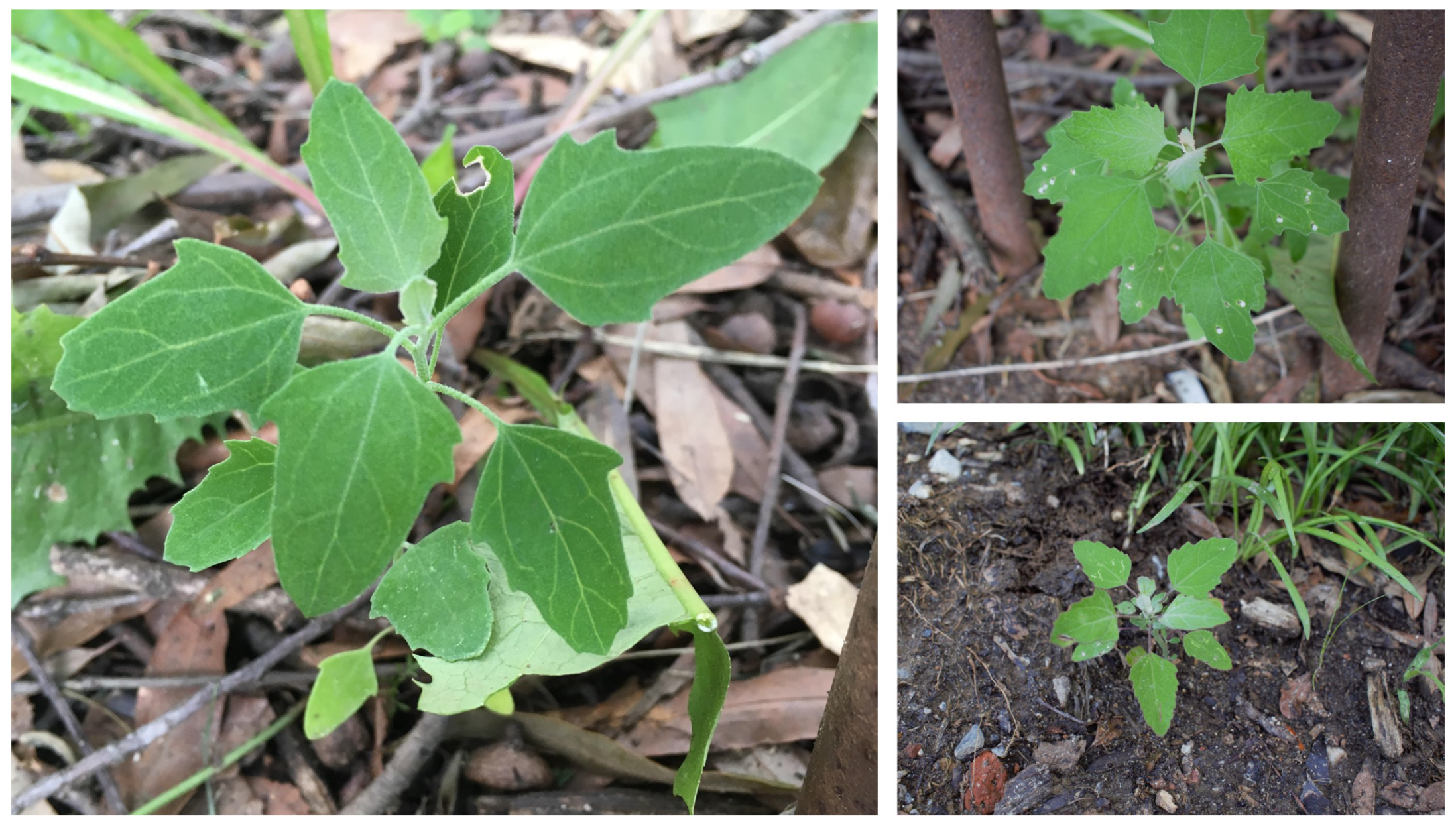
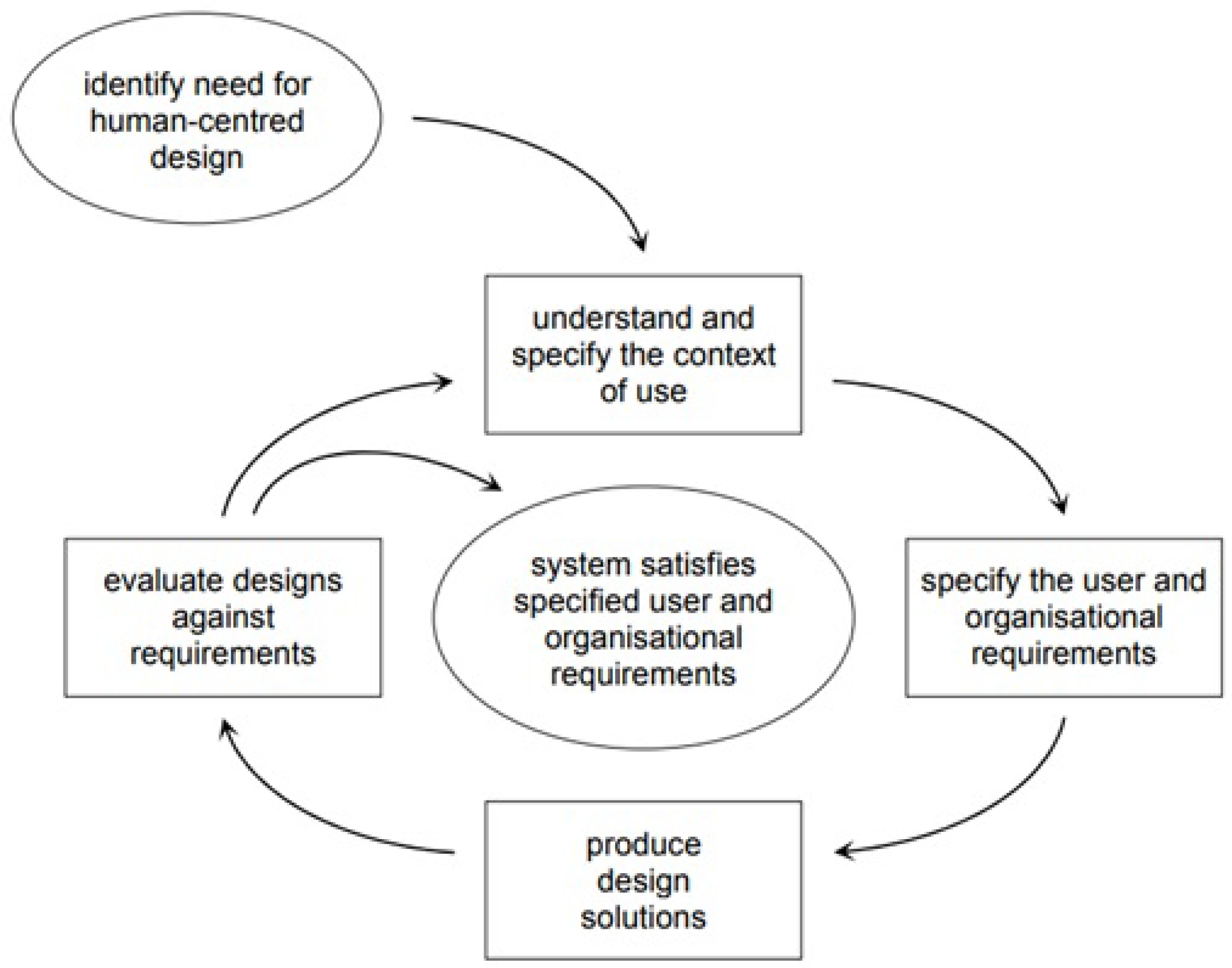


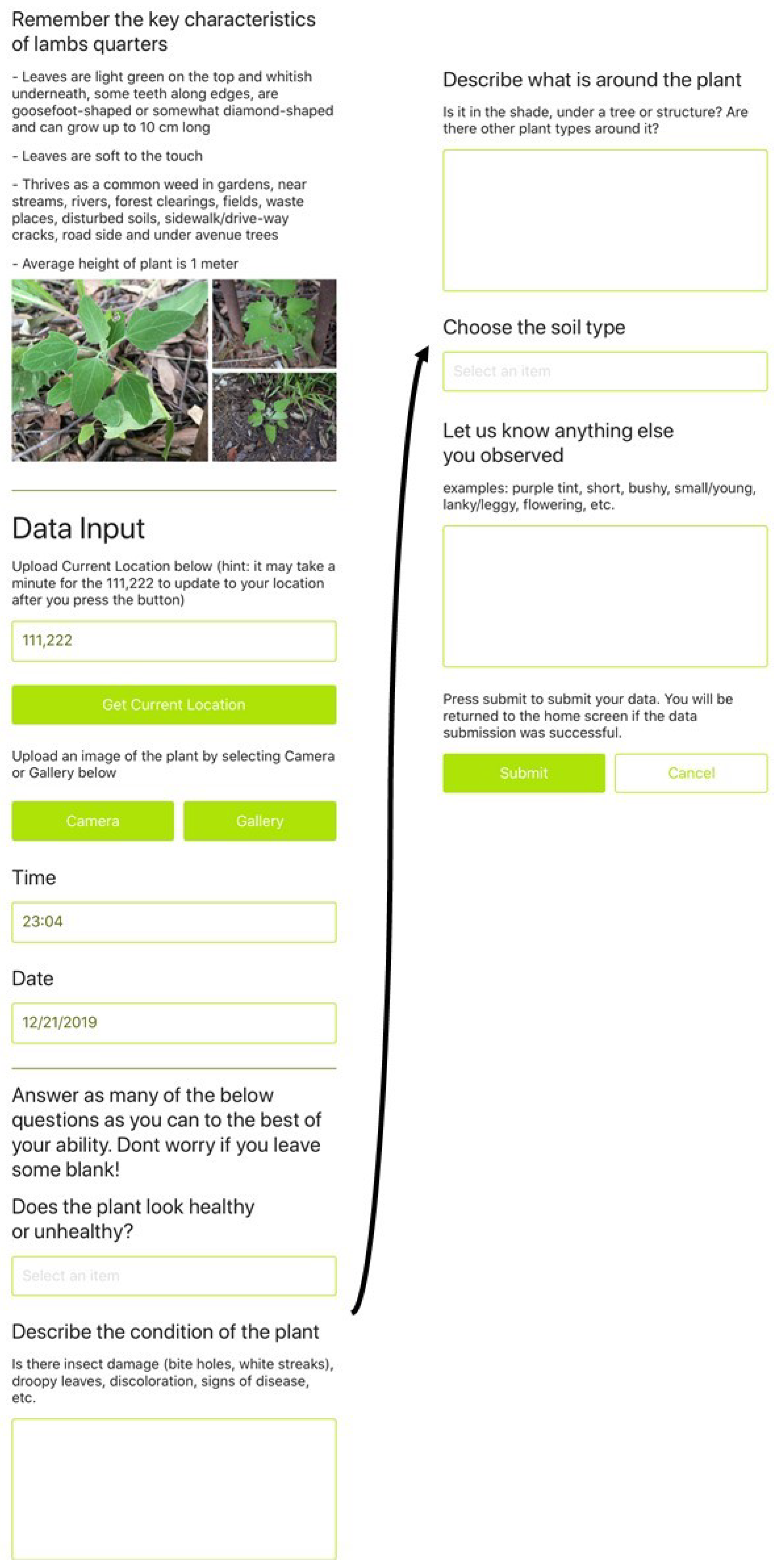


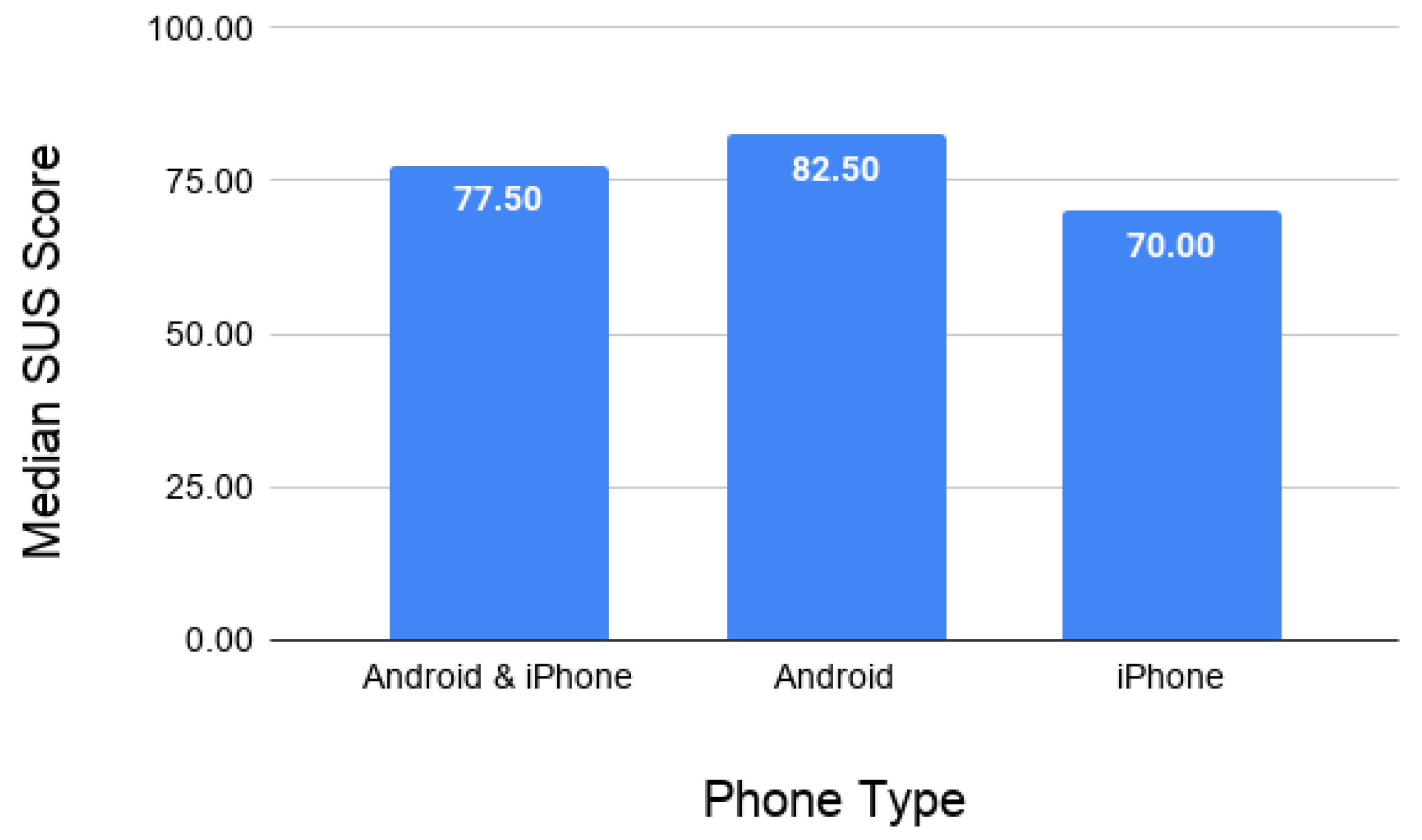

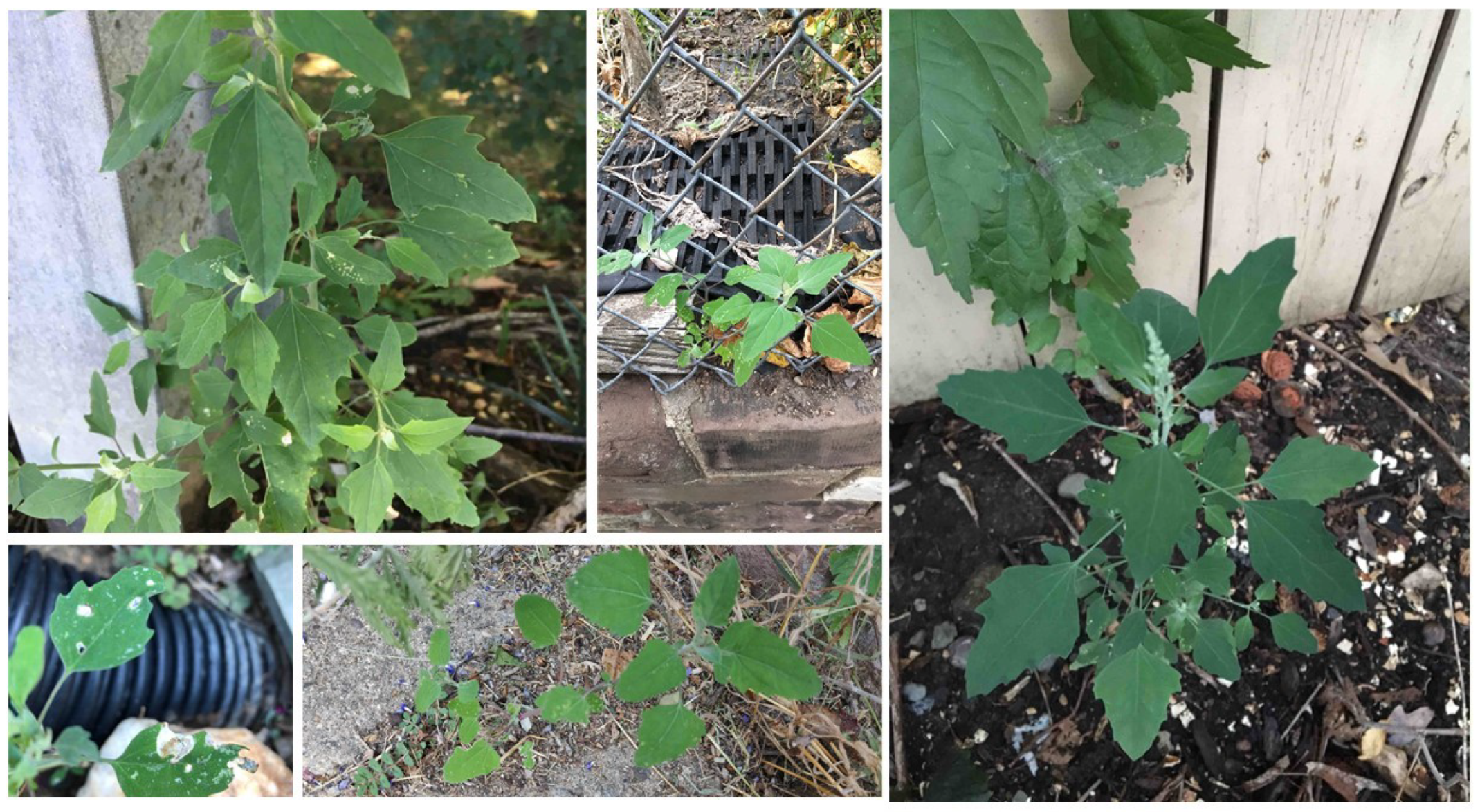

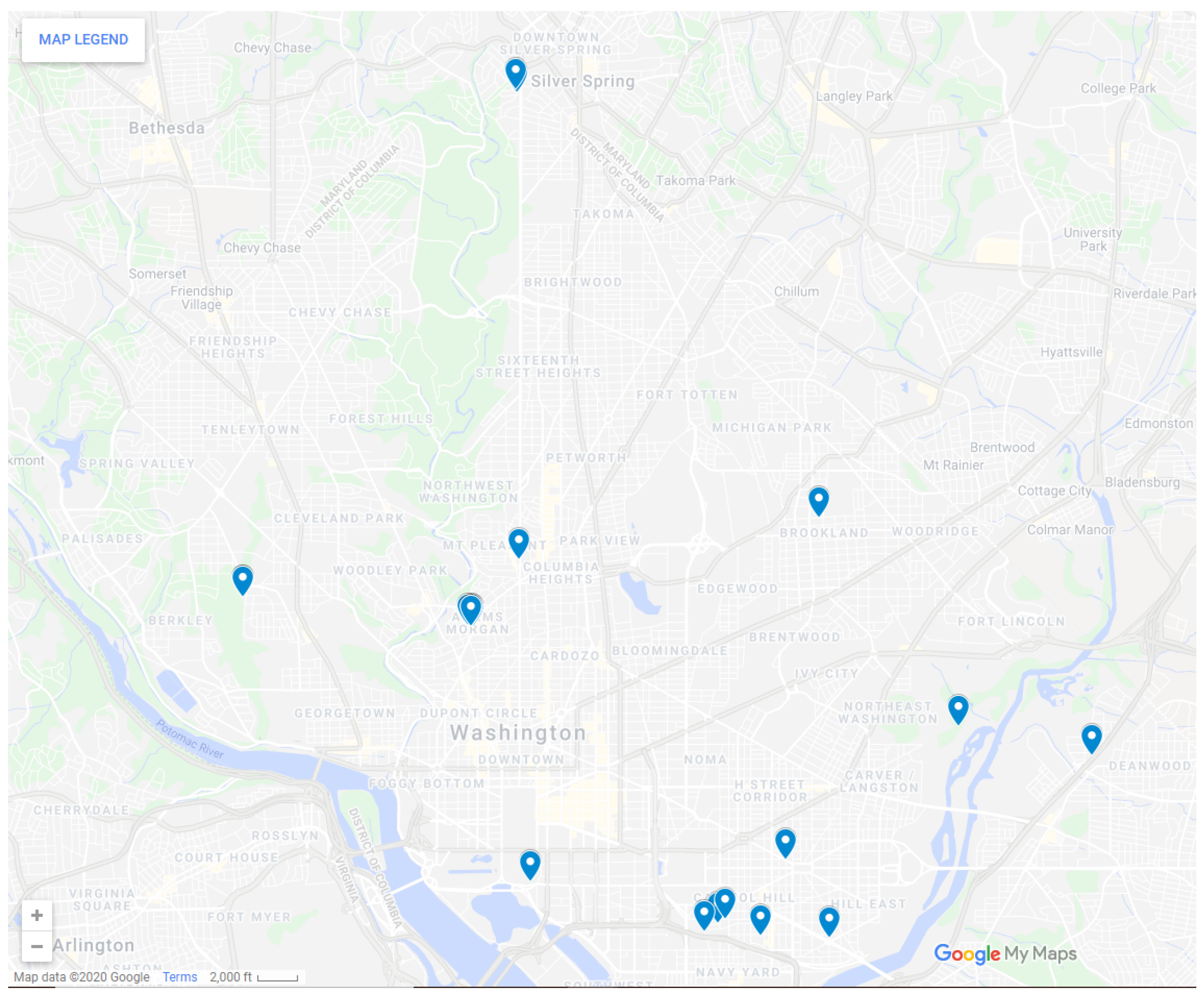
| Date | Location | Number of Participants |
|---|---|---|
| 10 August 2019 | Meridian Hill Park | 0 |
| 17 August 2019 | National Mall | 1 |
| 24 August 2019 | Montrose Park | 0 |
| 31 August 2019 | Rock Creek Park | 4 |
| 1–30 September 2019 | various locations in the DMV | 9 |
| Date | Location | Number of Participants |
|---|---|---|
| 27 October 2019 | National Arboretum | 0 |
| 29 October 2019 | National Arboretum | 0 |
| 31 October 2019 | National Arboretum | 0 |
| 1 November 2019 | National Arboretum | 2 |
| 2 November 2019 | National Arboretum | 1 |
| 3 November 2019 | National Arboretum | 0 |
| 1 December 2019 | ||
| 29 February 2020 | various locations in the DMV | 16 |
| Attribute | Value |
|---|---|
| N | 2 |
| Kendall’s W | 0.500 |
| Chi-Square | 24.000 |
| df | 24 |
| Asymp. Sig | 0.462 |
| Attribute | Value |
|---|---|
| N | 25 |
| tau-b | 0.327 |
| p | 0.109 |
Publisher’s Note: MDPI stays neutral with regard to jurisdictional claims in published maps and institutional affiliations. |
© 2021 by the authors. Licensee MDPI, Basel, Switzerland. This article is an open access article distributed under the terms and conditions of the Creative Commons Attribution (CC BY) license (https://creativecommons.org/licenses/by/4.0/).
Share and Cite
Posadas, B.B.; Hanumappa, M.; Niewolny, K.; Gilbert, J.E. Design and Evaluation of a Crowdsourcing Precision Agriculture Mobile Application for Lambsquarters, Mission LQ. Agronomy 2021, 11, 1951. https://doi.org/10.3390/agronomy11101951
Posadas BB, Hanumappa M, Niewolny K, Gilbert JE. Design and Evaluation of a Crowdsourcing Precision Agriculture Mobile Application for Lambsquarters, Mission LQ. Agronomy. 2021; 11(10):1951. https://doi.org/10.3390/agronomy11101951
Chicago/Turabian StylePosadas, Brianna B., Mamatha Hanumappa, Kim Niewolny, and Juan E. Gilbert. 2021. "Design and Evaluation of a Crowdsourcing Precision Agriculture Mobile Application for Lambsquarters, Mission LQ" Agronomy 11, no. 10: 1951. https://doi.org/10.3390/agronomy11101951





